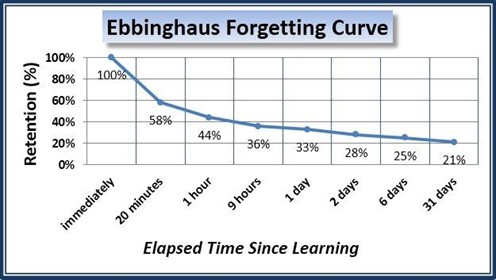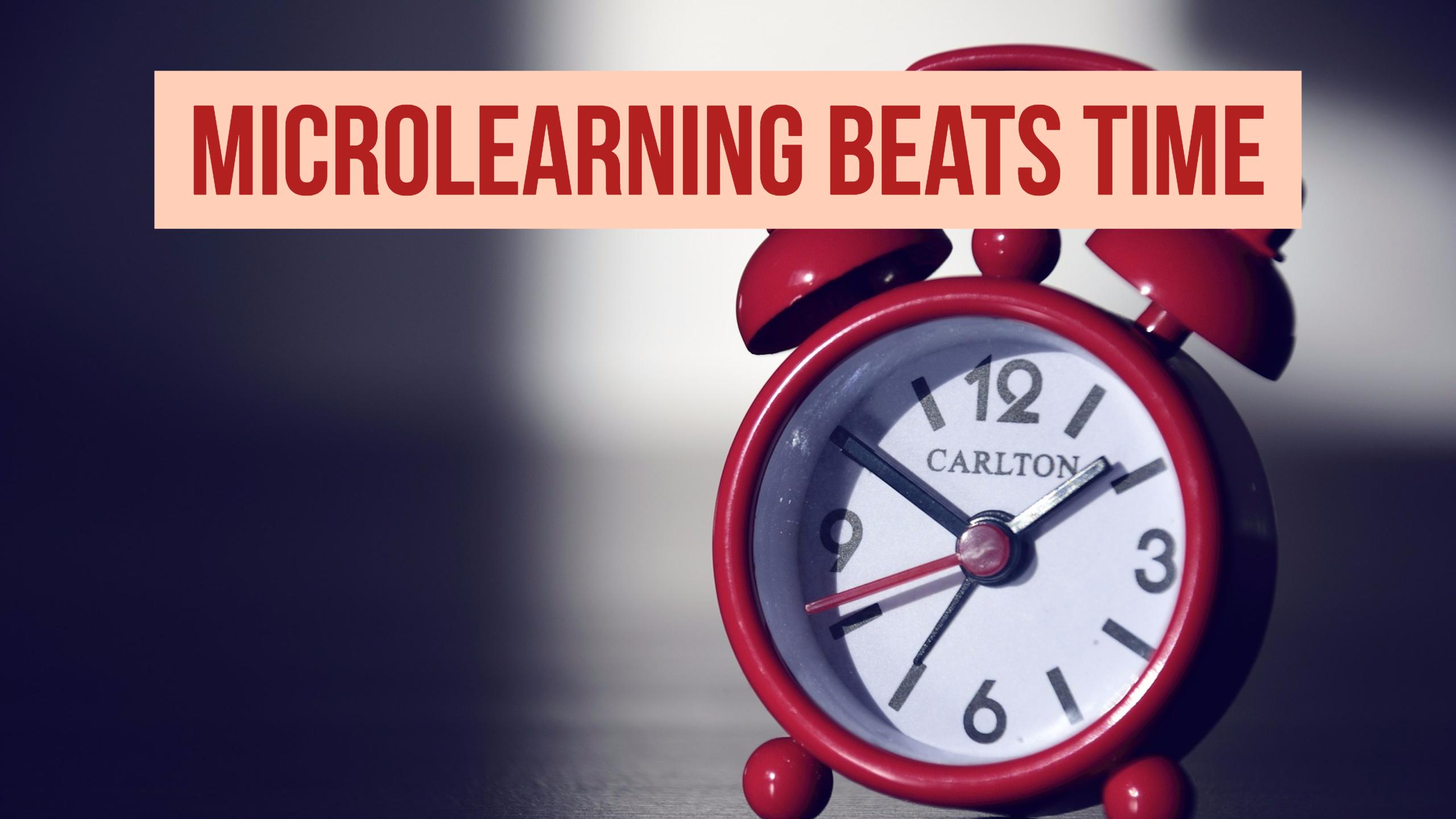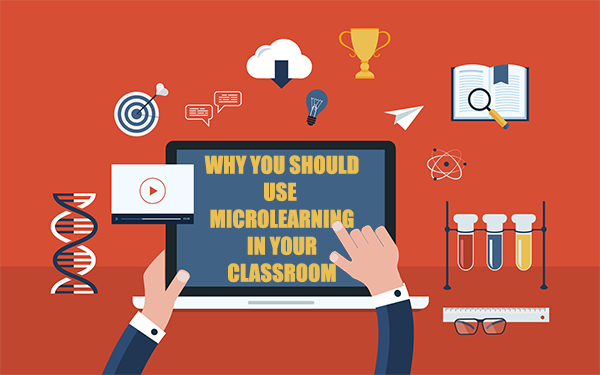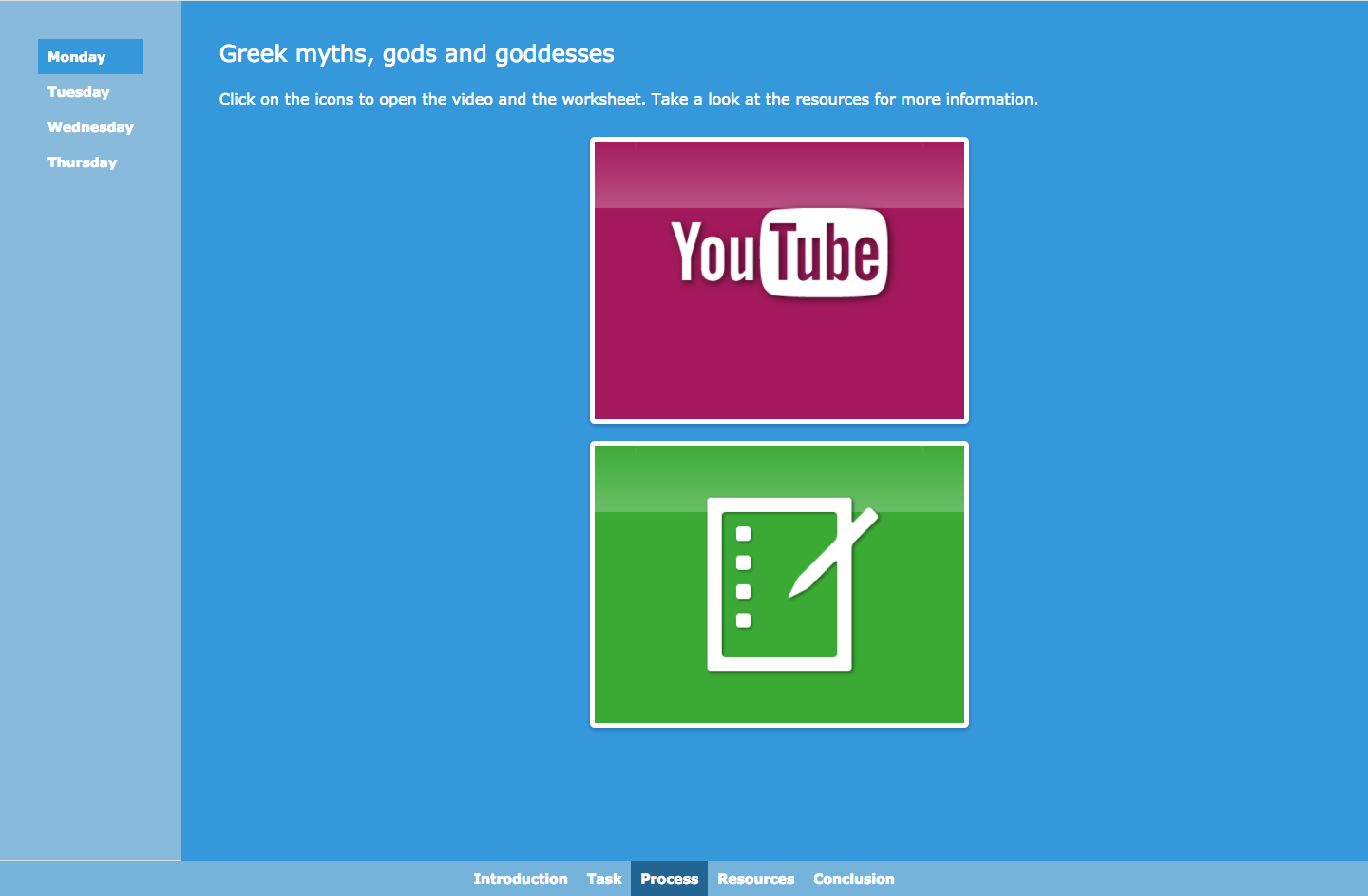Microlearning, a new way of teaching without losing attention
 Lucie Renard —
Lucie Renard —
When students are learning, a huge part of what you just taught them is long gone by the time they get home.
We all know Ebbinghaus’ forgetting curve. You can see that lots and lots of new information slips away immediately after a few minutes. After a month, students only remember 21% of what you taught them. Isn’t that frustrating?

Instead of giving your students long courses and letting them read long articles, and watch long videos, give them a micro course or, in other words, short lessons.
In this blog post, I’ll talk about an upcoming trend in education: microlearning. Try to make it all through the end. That’s where the fun examples come in!

What is microlearning?
Let’s start with the basics: what is (digital) microlearning? Well, digital microlearning is a method of learning via short, bite-sized and well-planned units that the students consume via digital media. As a teacher, you break down learning into short, manageable pieces of information.
Digital microlearning is used as a new method of content consumption. Studies have shown that there is a limit to how much information the brain can absorb and retain during a lesson.
You could compare microlearning with ‘chunking’. Chunking is a concept from the psychologist George Miller. He states that the brain can generally retain between five and nine facts before either committing them to long-term memory storage or losing them. That’s why it makes sense that these brain limitations lead to shorter lessons.
Microlearning has become increasingly popular due to new trends like eLearning and educational technology like tablets and smartphones. Microlearning can be implemented in any learning environment from a traditional classroom to flipped classrooms, virtual classrooms, and all places in-between.

Why microlearning benefits your classroom
Microlearning promises enormous benefits for students and teachers.
It solves a trend that has emerged in the digital education age: time. Teachers have less time to create content and students have less time to consume all the information. Students can learn anytime, anywhere they want, without spending hours and hours behind their desks studying.
1. Attention
 Traditional content learning models have a hard time reaching the students’ attention span (which is rapidly shrinking). According to the National Center for Biotechnology Information, the average attention span has shrunk from 12 seconds in 2000 to 8 seconds in 2013. That’s one second less than that of a goldfish! Even more impressive is that people switch between digital devices 21 times per hour. On top of that we can only tolerate 4 to 8 minutes of factual lecture before seeking other stimuli. This makes it difficult for students to retain any information from a long class.
Traditional content learning models have a hard time reaching the students’ attention span (which is rapidly shrinking). According to the National Center for Biotechnology Information, the average attention span has shrunk from 12 seconds in 2000 to 8 seconds in 2013. That’s one second less than that of a goldfish! Even more impressive is that people switch between digital devices 21 times per hour. On top of that we can only tolerate 4 to 8 minutes of factual lecture before seeking other stimuli. This makes it difficult for students to retain any information from a long class.
Those four to eight minutes are actually long enough to completely absorb digital microlearning (video) lessons. Every microlearning lesson is one module in a larger learning track that the teacher assigns on a given topic, and can be compared to chapters of a book.
2. Own learning pace
 The students choose their own learning pace at which they consume the information. The student can study or watch the content as many times as he wants at whatever speed he wishes.
The students choose their own learning pace at which they consume the information. The student can study or watch the content as many times as he wants at whatever speed he wishes.
In the end, students prove their learnings of the material by taking micro-assessments at the end of the module.
3. Time
 The microlearning lessons are short and therefore quick to produce. This is necessary given the short amount of time that teachers have to make their lesson plans.
The microlearning lessons are short and therefore quick to produce. This is necessary given the short amount of time that teachers have to make their lesson plans.
The turnaround time of a conventional textbook is about five years. Most subjects studied in school may change infrequently enough in those textbooks, but with the accelerated change in the digital world, the old model of static textbooks isn’t useful anymore. That’s where microlearning comes in handy. A modern system that allows training modules to be created and consumed quickly.

4. Digital devices
 Finally, the growing variety and affordability of smart devices is making digital content more accessible than ever. Digital microlearning lessons can be consumed on an Apple Watch just as easily as on a Smartphone, tablet or desktop.
Finally, the growing variety and affordability of smart devices is making digital content more accessible than ever. Digital microlearning lessons can be consumed on an Apple Watch just as easily as on a Smartphone, tablet or desktop.

4 Tips to implement microlearning
Microlearning can be implemented in your classroom with a few best practice guidelines. Keep some fundamental design and delivery guidelines in mind, like these:
1. Objective
 Each microlearning unit should be focused on a specific objective. So don’t try to push 30 minutes’ worth of content into 5 minutes. Keep it clear and follow your objectives.
Each microlearning unit should be focused on a specific objective. So don’t try to push 30 minutes’ worth of content into 5 minutes. Keep it clear and follow your objectives.
2. Make it interactive
 Keep it engaging and interactive. Just because it’s short doesn’t mean your students will be intrinsically interested. 5 Boring minutes equals 5 boring minutes.
Keep it engaging and interactive. Just because it’s short doesn’t mean your students will be intrinsically interested. 5 Boring minutes equals 5 boring minutes.
3. Keep in mind the learning goal
 A series of microlearning events must lead toward a larger learning goal. One short lesson without greater context will not have the same impact and will only confuse the students.
A series of microlearning events must lead toward a larger learning goal. One short lesson without greater context will not have the same impact and will only confuse the students.
4. Don’t overwhelm your students
 Don’t overwhelm your students with a constant series of these bite-sized learning modules. Schedule them with some time in between each one.
Don’t overwhelm your students with a constant series of these bite-sized learning modules. Schedule them with some time in between each one.
Microlearning implementation isn’t a must in your classroom. Yes, it’s a solution for the distraction and the short attention span of students, but make sure you stand behind it. It still takes work to figure out the right device and the right sizes of your micro-packages.

When not to use microlearning
Microlearning is NOT useful when students need to learn complex skills, processes, or behaviors.
Imagine trying to learn any of these behaviors or skills in a few minutes per day:
- A musical instrument
- Project management
- Instructional design
- Any software tool
- Teamwork skills
- Sales
- …
For some topics, microlearning can only learn you the theory and some basics. Skills, processes and behaviors can’t be learned by not actually DOING anything.

How you can use BookWidgets for microlearning
Ever heard of a WebQuest? Yes, I know, you wouldn’t think about a WebQuest when it comes to microlearning, but, never say never.
Take a look at this post to learn about the WebQuest. With BookWidget’s WebQuest widget, you can adjust everything. This makes it the ideal tool to use for microlearning. Take a look at this example:
Noticed the different steps? These are several microlearning lessons. The entire WebQuest represents a chapter.
Let your students discover each step. Make your microlearning lesson interactive by adding short YouTube videos and other game widgets. Changing the learning formats keeps their attention.
You can also use the hotspot image widget for fun micro-lessons. Take a look at the image below. Here’s a quick history micro-lesson about country music. Click on the image to open it.
It’s an image with information on it. Students have to discover the image and learn from text, image, video and audio pop-ups. If that isn’t micro enough…?
Certainly, there are alternative apps available for your consideration. Click here to explore and discover more options.

Some nice school practices
Learning on the loo
Microlearning is also used in the business world to tutor employees.
Google even places one-page micro lessons in the restrooms of their engineering building, calling this practice “learning on the loo”.
Your entire school can, just like Google, implement a “learning on the loo” project. That would be awesome. Can’t wait to see some results! Let me know when you get there, will you?
Snapchat
What about Snapchat? Snapchat gives you the opportunity to easily make 10 second videos. You can put together a Snapchat story full of pictures and videos about a lesson topic. Students will love your mini learning videos at any time of the day. What better way to integrate real life with school? At least they know now that teachers are also just humans!
TED Talks
I really love TED Talks and you will too! TED is a global community, welcoming people from every discipline and culture who seek a deeper understanding of the world.
They believe in the power of ideas to change attitudes, lives and, ultimately, the world. TED Talks are free talks from the world’s most inspired thinkers.
Do your students need motivation and inspiration? Take a look at the TED-Ed videos. The TED-Ed project (TED’s education initiative) makes short video lessons (5-10 min.) worth sharing, aimed at educators and students.
Within the TED-Ed library of lessons, you will find carefully curated educational videos, many of which are collaborations between educators and animators nominated through the TED-Ed platform.
Wrap up
So, that’s it! I hope I explained the modern teaching technique, microlearning, clear enough so you can get to work. Good luck!
Have you given it a shot? I’m eager to hear about your experience! Feel free to share it in the Teaching with BookWidgets Facebook group to inspire others. To stay in the loop with the latest classroom inspiration blog posts, make sure to follow us on Twitter.
Don’t hesitate to connect with me on LinkedIn.





